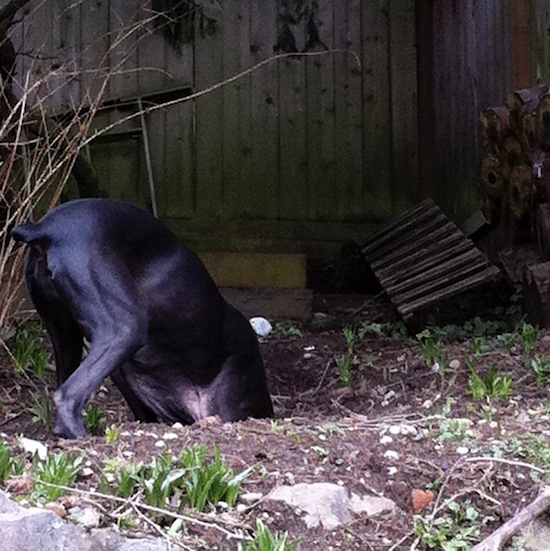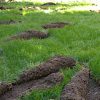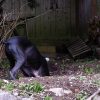It’s frustrating to come home and find your garden destroyed! Digging is a natural but destructive behavior if left unchecked. The good news is, that it can be redirected.
Digging is an instinct going back thousands of years. Primarily they dug holes in order to bury food to keep it safe from other animals, as well as to prevent it from spoiling until they could come back for it later.
Sometimes a dog wants to hide a special treasure and sometimes digging is just great fun not to mention it feels good on their toes. Dogs also like to lay in the coolness of freshly dug dirt – it even smells good!
You can’t always stop your dog from digging but a very effective option is to relocate the good times to a sanctioned digging zone. Try the following tips:
Before You Start, Keep These Things In Mind
The tone of your voice is everything when interacting with your dog (children and spouses included). Dogs differentiate good behavior from bad based on vocal inflections. Using a cheerful or soothing tone tells them you are pleased, whereas a “firm” tone (not yelling) indicates that you are serious. Yelling at them will only make them afraid resulting in unsuccessful training sessions. When you use a firm voice, along with respect and praise, learning will come much faster.
Use minimal words in your commands and use the same words every time. Dogs have a limited vocabulary. Too many words will only confuse the dog so keep your words simple and use the same ones every time: “Out”, “No Digging”, “Yes Dig Here”.
Whenever possible, supervise your dog when they are outside. Keeping an eye on your dog when they are outside is the best way to help them keep from digging elsewhere in the yard by immediately correcting the behavior.
The Basic Technique

1. Fence off areas that you don’t want them in at all like vegetable gardens, flower gardens, etc. You can find 2 foot high wire fences at your local garden center or home improvement stores.
2. Choose a portion of the yard where they can act on their urge without getting in trouble for doing it. Give them as big a play area as you can spare because there will be more than one hole dug.
3. Take them to this newly sanctioned digging area. Make it like a game – a teaching game. Hold their paws in your hands and dig a little hole in the ground using their paws while saying “Yes Dig Here” then stop and a dig a little hole with your hands (like a dog would) and say, “Yes, Dig Here”, then repeat with their paws. Make it fun! If it’s fun they are more likely to catch on quicker.
4. Repeat the digging action using their paws and the same upbeat voice so they can relate the words with the action. If they get into the activity and start digging during this part of the training – say it again – “Yes, Dig Here” to reinforce the good behavior in the right part of the yard.
5. To make sure they understand the difference between good and bad, walk them to the spot where they dug the forbidden hole. Point at it and say “No Digging” in a serious tone. Then, go back to the sanctioned digging area and cheerfully repeat “Yes Dig Here” and dig another hole together. Make sure you end the training on a positive note in the “good dog” area so they will feel confident about what just happened.
6. If you catch your dog digging outside of his area, tell the dog “Out” and “No Digging” in a firm tone. Then, immediately (but gently) lead the dog to their area of the yard to dig in and in a cheerful tone say, “Yes Dig Here”.
7. Reward your dog for good behavior. When your dog begins to dig or play in their special play area, praise them to show that you approve.
8. Everyone in the household needs to use the same procedure if they see the dog digging: use the same words with the same vocal inflections, show the dog the unacceptable hole “No Digging” serious tone, and then the acceptable digging area “Yes Dig Here” cheerful tone. This helps to reinforce the training and, the dog will learn the meaning of those phrases no matter who says them.
The Bottom Line
- Be Patient. It’s natural for most dogs to dig and while you can’t always get them to completely stop this behavior you can give them their own area to dig in. They might dig a few more illegal holes before they completely understand, but they’ll get it. Patience is key.
- Use simple words, and reward them for digging in their “sanctioned digging area” with loads of praise.
- Consistency is the main key to training your dog to do anything… and keeping it fun!
DogHouseandGarden.com is a participant in the Amazon Associates affiliate advertising program.
This program and others help us earn commissions by linking to online retailers.
Click here to see our Affiliate Disclosure page.
Views: 36






